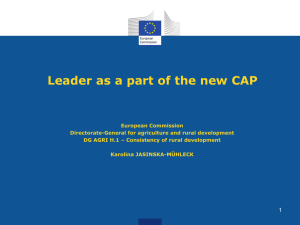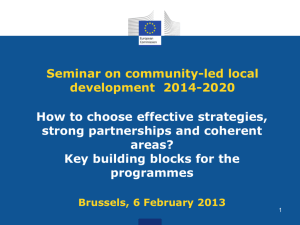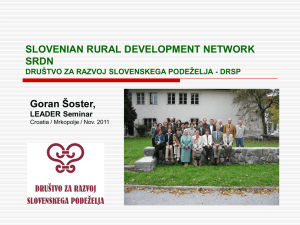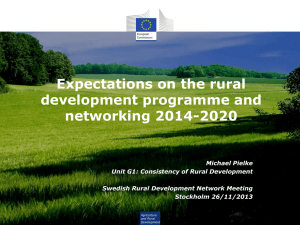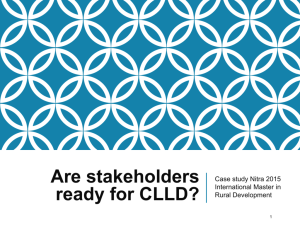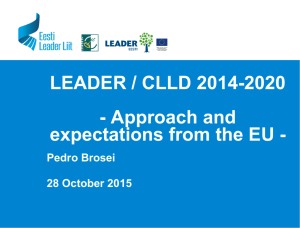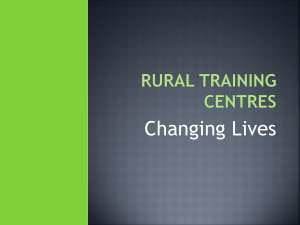CLLD in Hungary
advertisement
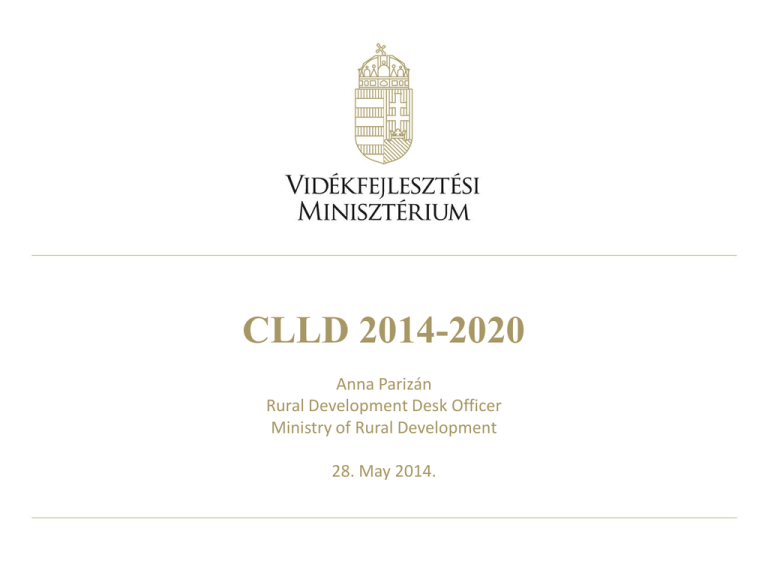
CLLD 2014-2020 Anna Parizán Rural Development Desk Officer Ministry of Rural Development 28. May 2014. Planning of the Rural Development Programme 2012. 2013. 2014. Monitoring of the New Hungary Rural Development Programme (2007-2013) Development of organizational structure Ex-ante Evaluation SWOT Analysis Strategic Environmental Assessment SWOT analysis, assessment VP 1.0 Development of goals and directions VP 2.0 Development of priorities VP 3.0 VP 4.0 Formulation of the indicative content of the measures Measures Monitoring and evaluation plan 2 EAFRD allocation for the programming period 2014-2020 Billion € 2007-2013 2014-2020 Change Change (%) EU total budget 994 960 -34 97 CAP budget 421 373 -48 89 Direct Payments 319 278 -41 87 Rural Development 98 85 -13 87 CAP budget in Hungary 10,4 12,3 1,9 118 Hungarian CAP budget in the EU (%) 2,36 3,19 0,83 135 Direct Payments in Hungary 6,6 8,8 2,3 135 Rural Development budget in Hungary 3,9 3,5 -0,4 89 EAFRD co-financing rates Hungary gives the maximum contribution (No national top-up): • Less developed regions (6 regions out of 7): 85% • Developed regions (Central Hungary): 53% • „Green" measures (all locations): 75% • Knowledge transfer; Producer groups; cooperation; LEADER: Developed regions: 80% Less developed regions: 90% • Financial instruments; I pillar amounts transferred: 100% 4 CLLD 2014-2020 Demarcation of rural areas Principles: • The demarcation is the same for the whole Priority 6 and CLLD/Leader; • There is no radical change regarding the demarcation of 2007-2013; • As result of the demarcation a settlement list will be delivered which will be part of the calls. • We consider it important to provide opportunities for the urban-rural cooperation. The demarcation of 2014-2020 is based on the programming period 2007-2013. The definition of rural areas (2014-2020): • Settlements with less than 10.000 (3007 settlements with 3,97 million inhabitants, 75 775 km2) • Population density with less than 120 inhabitants/km2 (another 35 settlements with 591 410 million inhabitants, 7007 km2) • Settlements which would be excluded based on these criteria, but the inhabitants of its periphery is more than 2% (only with the periphery) . 5 LAGs 2007-2013 - 96 LAGs - The whole rural area of Hungary was covered by LAGs 6 LAGs 2014-2020 • After a long process the final decision on CLLD is: MONOFUND + calls from other founds for LAGs. Those measures won’t be indicated in the LDSs. • Pilot programme: ERDF/ESF – CLLD in cities • The process of the reorganization and preliminary recognition of the future LAG territories almost finished. • The whole eligible country should be covered (110 LAGs) – but smaller budget 2007-2013: more than 480 million EUR from Axis III through LAGs 272 million EUR on LEADER Total amount: 752 million EUR 2014-2020: CLLD public expenditure in rural areas: 170 million EUR • Population covered by LAG – 4.5 million inhabitants 7 Standardisation of LAGs Training Since there is an uncertainty in the system (the Government didn’t set up yet, there is no MA for 2014-2020, etc.) difficult to plan the trainings. Without any certain framework we plan: • • • • On-going trainings; Online e-learning system (set up until 31th of May); Translation of the CLLD Guide to Hungarian; Providing templates for LDS. 8 Training - Thematic modules I. Title of the module 1. 2. EU, CAP, LEADER approach How to develop and implement a strategy? 3. Community based planning 4. 5. Local economy development Community building and social development 6. 7. 8. Environment Sustainability and global issues Cooperation and networking 9 Training - Thematic modules II. The structure (minimum content) of a module: • clarifying the definitions (e.g. LDS, innovation, beneficiary, etc.), • theoretical background, • practical and good practice examples, • workshop. The training organization has to provide the following tools per modules: • thematic education plan, • ppt presentation or other format, • 20-50 pages "textbook" per modules, • list of recommended professional literature. The participation is obligatory for the potential LAG managers and optional for the other stakeholders dealing with LEADER. As closure an examination will be organized. 10 „Bridge the gap” On-going implementation of the following measures: LEADER – Implementation of the LDS 3rd call LEADER – Transnational cooperation LEADER – Inter-territorial cooperation Axis III. – Development of tourism activities Additional duties: • • • • Territorial reorganization (already done) Training Preparation of the LDS Evaluation of the period 2007-2013 11 Thank you for your kind attention! Anna Parizán Ministry of Rural Development Department of Rural Development Rural Development Unit 1055 Budapest, Kossuth tér 11. e-mail: anna.parizan@vm.gov.hu 12
